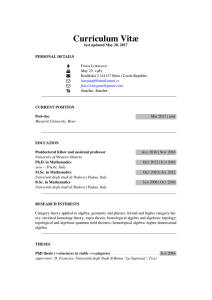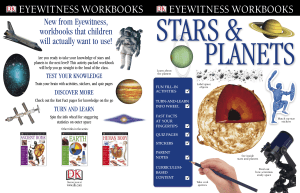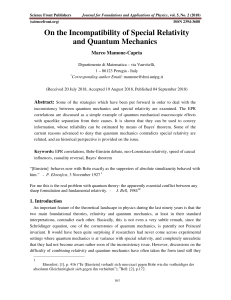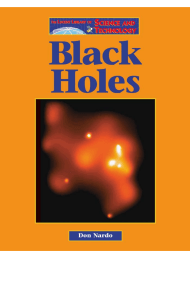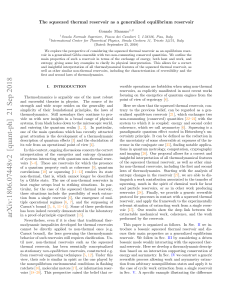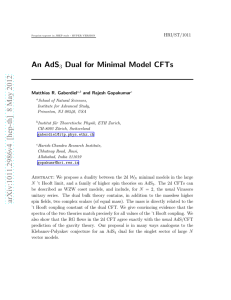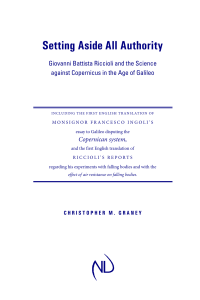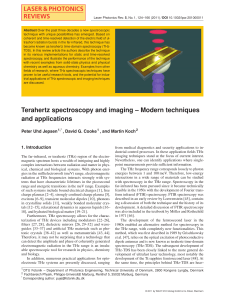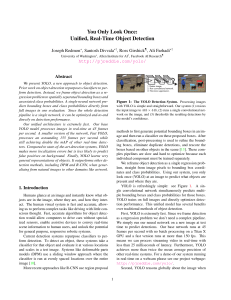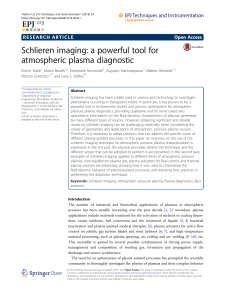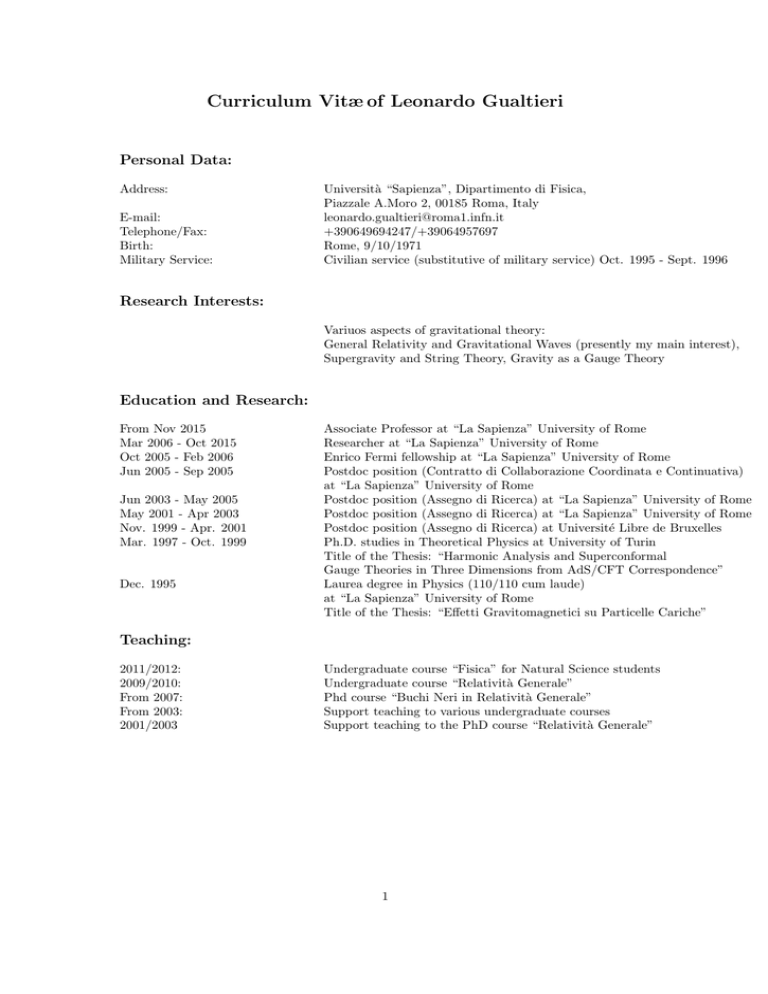
Curriculum Vitæ of Leonardo Gualtieri
Personal Data:
Address:
E-mail:
Telephone/Fax:
Birth:
Military Service:
Università “Sapienza”, Dipartimento di Fisica,
Piazzale A.Moro 2, 00185 Roma, Italy
[email protected]
+390649694247/+39064957697
Rome, 9/10/1971
Civilian service (substitutive of military service) Oct. 1995 - Sept. 1996
Research Interests:
Variuos aspects of gravitational theory:
General Relativity and Gravitational Waves (presently my main interest),
Supergravity and String Theory, Gravity as a Gauge Theory
Education and Research:
From Nov 2015
Mar 2006 - Oct 2015
Oct 2005 - Feb 2006
Jun 2005 - Sep 2005
Jun 2003 - May 2005
May 2001 - Apr 2003
Nov. 1999 - Apr. 2001
Mar. 1997 - Oct. 1999
Dec. 1995
Associate Professor at “La Sapienza” University of Rome
Researcher at “La Sapienza” University of Rome
Enrico Fermi fellowship at “La Sapienza” University of Rome
Postdoc position (Contratto di Collaborazione Coordinata e Continuativa)
at “La Sapienza” University of Rome
Postdoc position (Assegno di Ricerca) at “La Sapienza” University of Rome
Postdoc position (Assegno di Ricerca) at “La Sapienza” University of Rome
Postdoc position (Assegno di Ricerca) at Université Libre de Bruxelles
Ph.D. studies in Theoretical Physics at University of Turin
Title of the Thesis: “Harmonic Analysis and Superconformal
Gauge Theories in Three Dimensions from AdS/CFT Correspondence”
Laurea degree in Physics (110/110 cum laude)
at “La Sapienza” University of Rome
Title of the Thesis: “Effetti Gravitomagnetici su Particelle Cariche”
Teaching:
2011/2012:
2009/2010:
From 2007:
From 2003:
2001/2003
Undergraduate course “Fisica” for Natural Science students
Undergraduate course “Relatività Generale”
Phd course “Buchi Neri in Relatività Generale”
Support teaching to various undergraduate courses
Support teaching to the PhD course “Relatività Generale”
1
Computing experience:
Linux, Windows and MacOS environments, Fortran, Mathematica, Maple
Languages spoken:
English (fluent), French (good knowledge), Italian (mother language)
Awards and Grants:
From 2014:
2013
2012
2011
2007
2003
1996
1992
National Coordinator of the TEONGRAV Specific Initiative of INFN
National Habilitation in Theoretical Physics (Full Professor)
and Astrophysics (Associate Professor)
Research Grant from “Sapienza” University
IRSES Grant from European Commission, within the FP7 Program
“Honorable Mention” from the Gravity Research Foundation
Research Grant “Progetto Giovani Ricercatori” from
Italian University Ministry
“Luca Branca” fellowship for recent graduates in Astrophysics
“Persico” fellowship for Physics students from
Accademia Nazionale dei Lincei
Member of the organizing
committee of the
following Conferences:
2013
Strong Gravity Beyond GR: from Theory to Observations
Lisbon (Portugal)
2012
Problemi Attuali di Fisica Teorica
Vietri sul Mare, Salerno (Italy)
2011
Numerical Relativity and High Energy Physics
Madeira (Portugal)
2010
Neutron Stars as Gravitational Wave Sources
Monte Porzio, Rome (Italy)
International
Collaborations
Presently Active:
Departament de Fisica Aplicada, Universitat d’Alacant (Spain)
Department of Cosmology and Gravitation, University of Portsmouth (UK)
Centro Multidisciplinar de Astrofisica, Universidade de Lisboa (Portugal)
Department of Physics and Astronomy, University of Mississippi, MS (USA)
Max Planck Institut fur Gravitaionsphysik, Potsdam (Germany)
IOFFE Institute, St. Petersburg (Russia)
2
Publication List
Articles in refereed journals:
R82
“Perturbed black holes in Einstein-dilaton-Gauss-Bonnet gravity:
stability, ringdown, and gravitational-wave emission”
J.L. Blázquez-Salcedo, C.F.B. Macedo, V. Cardoso, V. Ferrari,
L. Gualtieri, F.S. Koo, J. Kunz, P. Pani
arxiv:1609.01286, Phys. Rev. D94 (2016) 104024
R81
“Testing the black hole ’no-hair’ hypothesis”
V. Cardoso, L. Gualtieri
arXiv:1607.03133, Class. Quant. Grav. 33 (2016) 174001
R80
“Spin evolution of a proto-neutron star”
G. Camelio, L. Gualtieri, J.A. Pons, V. Ferrari
arXiv:1601.02945, Phys. Rev. D94 (2016) 024008
R79
“Tidal Love numbers of a slowly-spinning neutron star”
P. Pani, L. Gualtieri, V. Ferrari
arXiv:1509.02171, Phys. Rev. D92 (2015) 124003
R78
“Testing general relativity with present and future astrophysical observations”
E. Berti, E. Barausse, V. Cardoso, L. Gualtieri, et al.
arXiv:1501.07274, Class. Quant. Grav. 32 (2015) 243001
R77
“Rotating black holes in Einstein-Dilaton-Gauss-Bonnet gravity with finite coupling”
A. Maselli, P. Pani, L. Gualtieri, V. Ferrari
arXiv:1507.07079, Phys. Rev. D92 (2015) 083014
R76
“Superradiant instability of the Kerr brane”
A. Ishibashi, P. Pani, L. Gualtieri, V. Cardoso
arXiv:1507.07079, J.H.E.P. 209 (2015) 1
R75
“Tensor-multi-scalar theories: relativistic stars and 3+1 decomposition”
M. Horbatsch, H.O. Silva, D. Gerosa, P. Pani, E. Berti, L. Gualtieri, U. Sperhake
arXiv:1505.17462, Class. Quant. Grav. 32 (2015) 204001
R74
“Exploring New Physics Frontiers Through Numerical Relativity”
V. Cardoso, L. Gualtieri, C. Herdeiro, U. Sperhake”
arXiv:1409.0014, Liv. Rev. Rel. 18 (2015) 1
R73
“Tidal deformations of a spinning compact object”
P. Pani, L. Gualtieri, A. Maselli, V. Ferrari”
arXiv:1503.07365, Phys. Rev. D92 (2015) 024010
R72
“Testing gravity with quasi-periodic oscillations from accreting black holes:
the case of the Einstein-Dilaton-Gauss-Bonnet theory”
A. Maselli, L. Gualtieri, P. Pani, L. Stella, V. Ferrari
arXiv:1412.3473, Astrophys. J. 810 (2015) 115
R71
“Higher dimensional Numerical Relativity: code comparison”
H. Witek, H. Okawa, V. Cardoso, L. Gualtieri, C. Herdeiro, M. Shibata, U. Sperhake, M. Zilhao
arXiv:1406.2703, Phys. Rev. D90 (2014) 084014
3
R70
“Rotating proto-neutron stars: spin evolution, maximum mass and I-Love-Q relations”
G. Martinon, A. Maselli, L. Gualtieri, V. Ferrari
arXiv:1406.7661, Phys. Rev. D90 (2014) 064026
R69
“Quasinormal modes of superfluid neutron stars”
L. Gualtieri, E.M. Kantor, M.E. Gusakov, A.I. Chugunov
arXiv:1404.7512, Phys. Rev. D90 (2014) 204010
R68
“Constraining the equation of state of nuclear matter with gravitational
wave observations: Tidal deformability and Tidal disruption”
A. Maselli, L. Gualtieri, V. Ferrari
arXiv:1310.5381, Phys. Rev. D88 (2013) 104040
R67
“Scalar, electromagnetic, and gravitational perturbations of
Kerr-Newman black holes in the slow-rotation limit”
P. Pani, E. Berti, L. Gualtieri
arXiv:1304.1160, Phys. Rev. D88 (2013) 064048
R66
“Equation-of-state-independent relations in neutron stars”
A. Maselli, V. Cardoso, V. Ferrari, L. Gualtieri, P. Pani
arXiv:1304.2052, Phys. Rev. D88 (2013) 023007
R65
“Gravito-Electromagnetic Perturbations of Kerr-Newman
Black Holes: Stability and Isospectrality in the Slow-Rotation Limit”
P. Pani, E. Berti, L. Gualtieri
arXiv:1304.1160, Phys. Rev. Lett. 110 (2013) 241103
R64
“Numerical simulations of single and binary black holes in
scalar-tensor theories: circumventing the no-hair theorem”
E. Berti, V. Cardoso, L.Gualtieri, M. Horbatsch, U. Sperhake
arXiv:1304.2836, Phys. Rev. D87 (2013) 124020
R63
“Dissipation in relativistic superfluid neutron stars”
M.E. Gusakov, E.M. Kantor, A.I. Chugunov, L. Gualtieri
arXiv:1211.2452, Mon. Not. Roy. Astron. Soc. 428 (2013) 1518
R62
“NR/HEP: roadmap to the future”
V. Cardoso, L. Gualtieri, C. Herdeiro, U. Sperkake, et al.
arXiv:1201.5118, Class. Quant. Grav. 29 (2012) 24401
R61
“Perturbations of slowly rotating black holes: massive vector fields in the Kerr metric”
P. Pani, V. Cardoso, L. Gualtieri, E. Berti, A. Ishibashi
arXiv:1209.0773, Phys. Rev. D86 (2012) 104017
R60
“Black hole bombs and photon mass bounds”
P. Pani, V. Cardoso, L. Gualtieri, E. Berti, A. Ishibashi
arXiv:1209.0465, Phys. Rev. Lett. 109 (2012) 131102
R59
“On the validity of the adiabatic approximation in compact binary inspirals”
A. Maselli, L. Gualtieri, F. Pannarale, V. Ferrari
arXiv:1205.7006, Phys. Rev. D86 (2012) 044032
4
R58
“Light scalar field constraints from gravitational-wave observations of compact binaries”
E. Berti, L. Gualtieri, M. Horbatsch, J. Alsing
arXiv:1204.4340, Phys. Rev. D85 (2012) 122005
R57
“Dynamics of black holes in de Sitter spacetimes”
M. Zilhao, V. Cardoso, L. Gualtieri, C. Herdeiro, U. Sperhake, H. Witek
arXiv:1204.2019, Phys. Rev. D85 (2012) 104039
R56
“Tidal interaction in compact binaries: A post-Newtonian affine framework”
V. Ferrari, L. Gualtieri, A. Maselli
arXiv:1111.6607, Phys. Rev. D85 (2012) 044045
R55
“Floating and sinking: the imprint of massive scalars
around rotating black holes”
V. Cardoso, S. Chakrabarti, P. Pani, E. Berti, L. Gualtieri
arXiv:1109.6021, Phys. Rev. Lett. 107 (2011) 241101
R54
“Higher-dimensional puncture initial data”
M. Zilhao, M. Ansorg, V. Cardoso, L. Gualtieri, C. Herdeiro, U. Sperhake, H. Witek
arXiv:1109.2149, Phys. Rev. D84 (2011) 084039
R53
“Oscillations of hot, young neutron stars:
Gravitational wave frequencies and damping times”
F. Burgio, V. Ferrari, L. Gualtieri, H.-J. Schultze
arXiv:1106.2736, Phys. Rev. D84 (2011) 044017
R52
“Gravitational waves from extreme mass-ratio inspirals
in Dynamical Chern-Simons gravity”
P. Pani, V. Cardoso, L. Gualtieri
arXiv:1104.1183, Phys. Rev. D83 (2011) 104048
R51
“Structure, Deformations and Gravitational Wave Emission
of Magnetars“
L. Gualtieri, R. Ciolfi, V. Ferrari
arXiv:1011.2778, Class. Quant. Grav. 28 (2011) 114014
R50
“Head-on collisions of unequal mass black holes in D=5 dimensions”
H. Witek, V. Cardoso, L. Gualtieri, C. Herdeiro, U. Sperhake, M. Zilhao
arXiv:1011.0742, Phys. Rev. D83 (2011) 044017
R49
“Black hole-neutron star coalescing binaries”
V. Ferrari, L. Gualtieri, F. Pannarale
Int. J. Mod. Phys. D19 (2010) 1241
R48
“Numerical relativity for D dimensional space-times: head-on collisions of black holes
and gravitational wave extraction”
H. Witek, M. Zilhao, L. Gualtieri, V. Cardoso, C. Herdeiro, A. Nerozzi, U. Sperhake
arXiv:1006.3081, Phys. Rev. D82 (2010) 104014
R47
“Gravitational signature of Schwarzschild black holes in
dynamical Chern-Simons gravity”
C. Molina, P. Pani, V. Cardoso, L. Gualtieri
arXiv:1004.4007, Phys. Rev. D81 (2010) 124021
5
R46
“Structure and deformations of strongly magnetized neutron stars with
twisted torus configurations”
R. Ciolfi, V. Ferrari, L. Gualtieri
arXiv:1003.2148, Mon. Not. Roy. Astron. Soc. 406 (2010) 2540
R45
“Numerical relativity for D dimensional axially symmetric space-times:
formalism and code tests”
M. Zilhao, H. Witek, U. Sperhake, V. Cardoso, L. Gualtieri, C. Herdeiro, A. Nerozzi
arXiv:1001.2302, Phys. Rev. D81 (2010) 084052
R44
“Neutron star tidal disruption in mixed binaries:
the imprint of the equation of state”
V. Ferrari, L. Gualtieri, F. Pannarale
arXiv:0912.3692, Phys. Rev. D81 (2010) 064026
R43
“Threshold anomalies in Horava-Lifshitz-type theories”
G. Amelino-Camelia, L. Gualtieri, F. Mercati
arXiv:0911.5360, Phys. Lett. B686 (2010) 283
R42
“Comment on ‘Kerr Black Holes as Particle Accelerators to Arbitrarily High Energy’ ”
E. Berti, V. Cardoso, L. Gualtieri, F. Pretorius, U. Sperhake
arXiv:0911.2243, Phys. Rev. Lett. 103 (2009) 239001
R41
“Perturbations of Schwarzschild black holes in Dynamical Chern-Simons modified gravity”
V. Cardoso, L. Gualtieri
arXiv:0907.5008, Phys. Rev. D80 (2009) 064008
R40
“Relativistic models of magnetars: the twisted-torus magnetic field configuration”
R. Ciolfi, V. Ferrari, L. Gualtieri, J.A. Pons
arXiv:0903.0556, Mon. Not. Roy. Astron. Soc. 397 (2009) 913
R39
“A Semi-relativistic Model for Tidal Interactions in BH-NS Coalescing Binaries”
V. Ferrari, L. Gualtieri, F. Pannarale
arXiv:0801.2911, Class. Quant. Grav. 26 (2009) 125004
R38
“ Transformation of the multipolar components of gravitational radiation
under rotations and boosts”
L. Gualtieri, E. Berti, V. Cardoso, U. Sperhake
arXiv:0805.1017, Phys. Rev. D78 (2008) 044024
R37
“The Return of the membrane paradigm? Black holes and strings in the water tap”
V. Cardoso, O.J.C. Dias, L. Gualtieri
arXiv:0705.2777, Int. J. Mod. Phys. D17, (2008) 505
R36
“Relativistic models of magnetars: structure and deformations”
A. Colaiuda, V. Ferrari, L. Gualtieri, J. A. Pons
arXiv:0712.2162, Mon. Not. Roy. Astron. Soc. 385, 2080 (2008)
R35
“Quasi-normal modes and gravitational wave astronomy”
V. Ferrari, L. Gualtieri
arXiv:0709.0657, Gen. Rel. Grav. 40, 945 (2008)
6
R34
“New approach to the study of quasinormal modes of rotating stars”
V. Ferrari, L. Gualtieri, S. Marassi
arXiv:0709.2925, Phys. Rev. D76 (2007) 104033
R33
“Unstable g-modes in proto-neutron stars”
V. Ferrari, L. Gualtieri, J. A. Pons
arXiv:0709:0403, Class. Quant. Grav. 24 (2007) 5093
R32
“Quark matter imprint on gravitational waves from oscillating stars”
O. Benhar, V. Ferrari, L. Gualtieri, S. Marassi
astro-ph/0603464, Gen. Rel. Grav. 39 (2007) 1323
R31
“Equilibrium configurations of fluids and their stability in higher dimensions”
V. Cardoso, L. Gualtieri
gr-qc/0610004, Class. Quant. Grav. 23 (2006) 7151
R30
“Hybrid approach to black hole perturbations from extended matter sources”
V. Ferrari, L. Gualtieri, L. Rezzolla
gr-qc/0606059, Phys. Rev. D73 (2006) 124028
R29
“Coupling of radial and axial non-radial oscillations of compact
stars: gravitational waves from first-order differential rotation”
A. Passamonti, M. Bruni, L. Gualtieri, A. Nagar, C. F. Sopuerta
gr-qc/0601001, Phys. Rev. D73 (2006) 084010
R28
“Hawking emission of gravitons in higher dimensions: non-rotating black holes”
V. Cardoso, M. Cavaglià, L. Gualtieri
hep-th/0512116, J.H.E.P. 0602 (2006) 021
R27
“Black hole particle emission in higher dimensional spacetimes”
V. Cardoso, M. Cavaglià, L. Gualtieri
hep-th/0512002, Phys. Rev. Lett. 96 (2006) 071301
R26
“Perturbative approach to the structure of rapidly rotating neutron stars”
O. Benhar, V. Ferrari, L. Gualtieri, S. Marassi
gr-qc/0504068, Phys. Rev. D72 (2005) 044028
R25
“Relativistic r-modes and shear viscosity: regularizing the continuum spectrum”
J.A. Pons, L. Gualtieri, J.A. Miralles, V. Ferrari
astro-ph/0504062, Mon. Not. Roy. Astron. Soc. 363 (2005) 121
R24
“Coupling of radial and non-radial oscillations of relativistic stars:
gauge-invariant formalism”
A. Passamonti, M. Bruni, L. Gualtieri, C. Sopuerta
gr-qc/0407108, Phys. Rev. D71 (2005) 024022
R23
“Gravitational Wave asteroseismology reexamined”
O. Benhar, V. Ferrari, L. Gualtieri
astro-ph/0407529, Phys. Rev. D70 (2004) 124015
R22
“Non-adiabatic oscillations of compact stars in general relativity”
L. Gualtieri, J.A. Pons, G. Miniutti
gr-qc/0405063, Phys. Rev. D70 (2004) 084009
7
R21
“Nonlinear N –parameter spacetime perturbations: gauge transformations”
C. Sopuerta, M. Bruni, L. Gualtieri
gr-qc/0306027, Phys.Rev. D70 (2004) 064002
R20
“Gravitational waves from rotating proto–neutron stars”
V. Ferrari, L. Gualtieri, J.A. Pons, A. Stavridis
astro-ph/0409578, Class. Quant. Grav. 21 (2004) S515
R19
“Rotational effects on the oscillation frequencies of newly born proto–neutron stars”
V. Ferrari, L. Gualtieri, J.A. Pons, A. Stavridis
astro-ph/0310896, Mon. Not. Roy. Astron. Soc. 350 (2004) 763
R18
“Gravitational energy loss in high–energy particle collisions:
ultrarelativistic plunge into a multidimensional black hole”
E. Berti, M. Cavaglià, L. Gualtieri
hep-th/0309203, Phys. Rev. D69 (2004) 124011
R17
“Two–parameter non–linear spacetime perturbations:
gauge transformations and gauge invariance”
M. Bruni, L. Gualtieri, C. Sopuerta
gr-qc/0207105, Class. Quant. Grav. 20 (2003) 535
R16
“Non–radial oscillation modes as a probe of density discontinuities in neutron stars”
G. Miniutti, J.A. Pons, E. Berti, L. Gualtieri, V. Ferrari
astro-ph/0206142, Mon. Not. Roy. Astron. Soc. 338 (2003) 389
R15
“Are Post–Newtonian templates faithful and effectual in
detecting gravitational signals from neutron star binaries?”
E. Berti, J.A. Pons, G. Miniutti, L. Gualtieri, V. Ferrari
gr-qc/0208011, Phys. Rev. D66 (2002) 064013
R14
“Gravitational signals emitted by a point mass
orbiting a neutron star: effects of stellar stucture”
J.A. Pons, E. Berti, L. Gualtieri, G. Miniutti, V. Ferrari
gr-qc/0111104, Phys. Rev. D65 (2002) 104021
R13
“Gravitational signals emitted by a point mass
orbiting a neutron star: a perturbative approach”
L. Gualtieri, E. Berti, J. A. Pons, G. Miniutti, V. Ferrari
gr-qc/0107046, Phys. Rev. D64 (2001) 104007
R12
“Non–semisimple gaugings of D = 5 N = 8 supergravity”
L. Andrianopoli, F. Cordaro, P. Frè, L. Gualtieri
hep-th/0012203, Fortsch.Phys. 49, 511 (2001)
R11
“An exotic theory of massless spin–two fields in three dimensions”
N. Boulanger, L. Gualtieri
hep-th/0012003, Class. Quant. Grav. 18 (2001) 1485
R10
“Non-Semisimple Gaugings of D = 5 N = 8 Supergravity and FDA.s”
L. Andrianopoli, F. Cordaro, P. Frè, L. Gualtieri
hep-th/0009048, Class. Quant. Grav. 18 (2001) 395
8
R9
“Inconsistency of interacting, multi-graviton theories”
N. Boulanger, T. Damour, L. Gualtieri, M. Henneaux
hep-th/0007220, Nucl. Phys. B597 (2001) 127
R8
“The structure of N = 3 multiplets in AdS4 and the complete
Osp(3|4) × SU (3) spectrum of M -theory on AdS4 × N 010 ”
P.Frè, L.Gualtieri, P.Termonia
hep-th/9909188, Phys. Lett. B471 (1999) 27
R7
“3D superconformal theories from Sasakian seven-manifolds:
new nontrivial evidences for AdS4 /CF T3 ”
D.Fabbri, P.Frè, L.Gualtieri, C.Reina, A.Tomasiello, A.Zaffaroni, A.Zampa
hep-th/9907219, Nucl. Phys. B577 (2000) 547
R6
“Osp(N |4) supermultiplets as conformal superfields on
∂AdS4 and the generic form of N = ∈, d = 3 gauge theories”
D.Fabbri, P.Frè, L.Gualtieri, P.Termonia
hep-th/9905134, Class. Quant. Grav. 17 (2000) 55
R5
“M -theory on AdS4 × M 111 : the complete
Osp(2|4) × SU (3) × SU (2) spectrum from harmonic analysis”
D.Fabbri, P.Frè, L.Gualtieri, P.Termonia
hep-th/9903036, Nucl. Phys. B560 (1999) 617
R4
“Stellar Pulsations excited by a scattered mass”
A.Borrelli, V.Ferrari, L.Gualtieri
gr-qc/9901060, Phys. Rev. D59 (1999) 124020
R3
“N = 8 BP S Black Holes with 1/2 or 1/4 Supersymmetry
and Solvable Lie Algebra Decomposition”
G.Arcioni, A.Ceresole, F.Cordaro, R.D’Auria, P.Frè, L.Gualtieri, M.Trigiante
hep-th/9807136, Nucl. Phys. B542 (1999) 273
R2
“N = 8 Gauging Revisited: an Exaustive Classification”
F.Cordaro, P.Frè, L.Gualtieri, P.Termonia, M.Trigiante
hep-th/9804056, Nucl. Phys. B532 (1998) 245
R1
“On the Perturbations of a Nonrotating Star Excited by a Massive Source.
I. The Matching Conditions at the Surface of the Star”
V.Ferrari, L.Gualtieri
Int. J. Mod. Phys. D6, 3 (1997) 323
9
Contributions to conference proceedings:
C19
“Black holes in Einstein-Gauss-Bonnet-dilaton theory”
J.L.B. Salcedo et al.
Ljubljana, Slovenia, September 2016
Published in: Proceedings IAU Symposium 324, 2016
C18
“Preface by the editors”
C. Herderiro, E. Berti, V. Cardoso, L.C.B. Crispino, L. Gualtieri, U. Sperhake
Belem, Brazil, September-October 2015
Published in: Int. Journ. Mod. Phys. D25, 1602002, 2016
C17
“Recent developments in the tidal deformability of spinning compact objects”
P. Pani, L. Gualtieri, A. Maselli, V. Ferrari
Belem, Brazil, September-October 2015
Published in: Int. Journ. Mod. Phys. D25, 1641001, 2016
C16
“Numerical Relativity and High Energy Physics: Recent Developments”
E. Berti, V. Cardoso, L.C.B. Crispino, L. Gualtieri, C.Herdeiro, U. Sperhake
Belem, Brazil, September-October 2015
Published in: Int. Journ. Mod. Phys. D25, 1641022, 2016
C15
“The Large Observatory for x-ray timing”
M. Feroci et al.
Montreal, Canada, June 2014
Published in Proc. SPIE 9144, 91442T, 2014
C14
“Black Hole Collisions in Asymptotically de Sitter Spacetimes”
M. Zilhao, V. Cardoso, L. Gualtieri, C. Herdeiro, U. Sperhake, H. Witek
Prague, June 2012’
Published in Springer Proc. Phys. 157, 247, 2014
C13
“Relativistic astrophysics at GR20”
I. Mandel, M. Coleman Miller, et al.
Warsaw, Poland, July 2013
Published in: Gen. Rel. Grav. 46, 1688, 2014
C12
“Spring School on Numerical Relativity and High Energy Physics (NR/HEP2)”
V. Cardoso (ed.), L. Gualtieri (ed.), C. Herdeiro (ed.), U. Sperhake (ed.)
Lisbon, Portugal, March 2013
Published in: Int. Journ. Mod. Phys. A28, 22, 2013
C11
“On the validity of the adiabatic approximation in compact binary inspirals”
A. Maselli, L. Gualtieri, V. Ferrari
Proceedings of the 13th Marcel Grossman Meeting (MG13), arxiv:1302.5249
Stockholm, Sweden, July 2012
C10
“Numerical relativity in D dimensional space-times: collisions of unequal mass black holes”
H. Witek, V. Cardoso, L. Gualtieri, C. Herdeiro, U. Sperhake, M. Zilhao
Proceedings of the Spanish Relativity Meeting (ERE 2010)
Granada, Spain, September 2010
Published in: Journ. Phys. Conference Series, 314, 012104, 2011
10
C9
“Simulations of black holes in compactified spacetimes”
M. Zilhao, V. Cardoso, L. Gualtieri, C. Herdeiro, A. Nerozzi, U. Sperhake, H. Witek
Proceedings of the Spanish Relativity Meeting (ERE 2010)
Granada, Spain, September 2010
Published in: Journ. Phys. Conference Series, 314, 012103, 2011
C8
“Black holes in a box”
H. Witek, V. Cardoso, L. Gualtieri, C. Herdeiro, A. Nerozzi, U. Sperhake, M. Zilhao
Proceedings of the Spanish Relativity Meeting (ERE 2009)
Bilbao, Spain, September 2009
Published in: Journ. Phys. Conference Series, 229, 012072, 2010
C7
“Numerical relativity in higher dimensions”
M. Zilhao, H. Witek, U. Sperhake, V. Cardoso, L. Gualtieri, C. Herdeiro, A. Nerozzi
Proceedings of the Spanish Relativity Meeting (ERE 2009)
Bilbao, Spain, September 2009
Published in: Journ. Phys. Conference Series, 229, 012074, 2010
C6
“Relativistic r-modes and shear viscosity”
L. Gualtieri, J. A. Pons, J. A. Miralles, V. Ferrari, gr-qc/0702040
Proceedings of the Albert Einstein Century International Conference,
Paris, France, July 2005
Published in: AIP Conference Proceedings, 861, 638, 2006
C5
“Coupling of radial and non-radial oscillations of neutron stars”
A. Passamonti, M. Bruni, L. Gualtieri, C. F. Sopuerta, gr-qc/0411021
Proceedings of the NATO Advanced Study Institute on
the Electromagnetic Spectrum of Neutron Stars
Marmaris, Turkey, June 2004
C4
“Gravitational waves from neutron stars described by modern EOS”
O. Benhar, V. Ferrari, L. Gualtieri, gr-qc/0410140
Proceedings of the XVI SIGRAV conference
Vietri sul Mare, Salerno, Italy, September 2004
C3
“Non–linear relativistic perturbation theory with two parameters”
C. Sopuerta, M. Bruni, L. Gualtieri, gr-qc/0211080
Proceedings of the Spanish Relativity Meeting (ERE 2002)
Mao, Menorca, Spain, September 2002
C2
“No consistent cross-interactions for a collection of massless spin-2 fields”
N. Boulanger, T. Damour, L. Gualtieri, M. Henneaux, hep-th/0009109
Proceedings of the Meetings:
“Spring School in QFT and Hamiltonian Systems” Calimanesti, Romania, May 2000,
“Quantization, Gauge Theory and Strings” Moscow, Russia, June 2000
C1
“On the perturbation of non–rotating compact objects excited by massive sources”
A. Borrelli, L. Gualtieri, V. Ferrari
Proceedings of the 8th Marcel Grossmann meeting (MG8), Jerusalem, Israel, Jun 1997
Published in “Jerusalem 1997, Recent developments in theoretical and experimental
general relativity, gravitation, and relativistic field theories”
11
Presentations at conferences:
Sep 2016
22th SIGRAV Conference on General Relativity and Gravitational Waves
Cefalù, Palermo (Italy)
“Testing general relativity with gravitational waves and electromagnetic waves”
Mar 2016
Problemi Attuali di Fisica Teorica
Vietri sul Mare, Salerno (Italy)
“Testing gravity with gravitational-wave observations”
Feb 2016
What Next 2016
Rome (Italy)
“Fundamental physics with gravitational waves”
Jun 2015
Annual NewCompStar Conference 2015
Budapest (Hungary)
“On the tidal Love numbers of rotating neutron stars”
Jun 2015
One Hundred Years of Strong Gravity
Lisbon (Portugal)
“Accreting black holes as probes of strong-field gravity”
Nov 2014
NewCompstar WG3 Meeting
Lyon (France)
“Gravitational wave emission from individual stars”
Sep 2014
21th SIGRAV Conference on General Relativity and Gravitational Waves
Alessandria (Italy)
“Oscillations of neutron star and black holes in the eve of the advanced
gravitational wave detectors”
Apr 2014
Problemi Attuali di Fisica Teorica
Vietri sul Mare, Salerno (Italy)
“Quasi-normal modes of a relativistic superfluid neutron star”
Apr 2014
Gravitational Physics in the Next 20 Years
Napoli (Italy)
“Open questions in gravitational physics”
Mar 2014
The Structure and Signals of Neutron Stars
Firenze (Italy)
“On the gravitational signal from tidally deformed neutron stars in coalescing binaries”
Jul 2013
20th International Conference of General Relativity and Gravitation (GR20)
Warsaw (Poland)
“Black hole motion on a non-uniform scalar field in scalar-tensor theories”
Jul 2013
20th International Conference of General Relativity and Gravitation (GR20)
Warsaw (Poland)
“Quasi-normal modes of a relativistic superfluid neutron star”
12
Apr 2013
VESF school on gravitational waves, neutrinos and multiwavelength
electromagnetic observations: the new frontier of Astronomy
Monte Porzio Catone, Roma (Italy)
“Gravitational waves from neutron stars: rotation and oscillations”
Jun 2012
Compstar 2012: the Physics and Astrophysics of Compact Stars
Tahiti (French Polynesia)
“Gravitational waves from compact binary inspirals and neutron star EOS:
Love numbers or Love functions?”
Apr 2012
Problemi Attuali di Fisica Teorica
Vietri sul Mare, Salerno (Italy)
“Stellar Oscillations of Newly Born Neutron Stars”
Dec 2011
IV Workshop on Black Holes
Aveiro (Portugal)
“Gravitational wave sources in dynamical Chern-Simons gravity”
Sep 2011
Parma Workshop on Numerical Relativity and Gravitational Waves
Parma (Italy)
“Tidal interaction in compact binaries: a post-Newtonian affine framework”
May 2011
Compstar 2011: Gravitational waves and electromagnetic radiation
from compact stars
Catania (Italy)
“Stellar oscillations of hot, young neutron stars”
Mar 2011
Rencontres de Moriond 2011
La Thuile, Aosta (Italy)
“Neutron stars as gravitational wave sources”
Sep 2010
19th SIGRAV Conference on General Relativity and Gravitational Waves
Pisa (Italy)
“Neutron star equation of state and gravitational wave emission:
magnetars, tidal disruption, stellar oscillations”
Jul 2010
19th International Conference of General Relativity and Gravitation (GR19)
Mexico City (Mexico)
“Structure and deformations of magnetars with twisted torus fields”
Jul 2010
19th International Conference of General Relativity and Gravitation (GR19)
Mexico City (Mexico)
“Black hole oscillations in dynamical Chern-Simons gravity”
Mar 2010
Problemi Attuali di Fisica Teorica
Vietri sul Mare, Salerno (Italy)
“Structure and deformations of magnetars with twisted torus fields”
13
Jan 2010
14th Gravitational Wave Data Analysis Workshop
Roma (Italy)
“Structure and deformations of magnetars with twisted torus fields”
Dec 2009
2nd Workshop on Black Holes
Lisbon (Portugal)
“Oscillations and stability of black holes in dynamical Chern-Simons gravity”
Feb 2008
Neutron Star Dynamics Meeting
Gregynog (UK)
“Relativistic models of magnetars”
Oct 2007
4th ILIAS Meeting
Tubinga (Germany)
“Stable and unstable g-modes in proto-neutron stars”
Sep 2007
Matter at Extreme Densities and Gravitational Waves from Compact Objects
Trento (Italy)
“Relativistic models of magnetars”
Apr 2007
Problemi Attuali di Fisica Teorica
Vietri sul Mare, Salerno (Italy)
“Unstable g-modes in proto-neutron stars”
Dec 2006
3rd ILIAS/N6-ENTApP Meeting
Paris (France)
“Unstable g-modes in proto-neutron stars”
Sep 2006
17th SIGRAV Conference on General Relativity and Gravitational Waves
Turin (Italy)
“Gravitational waves from oscillations of relativistic stars”
Sep 2006
Mini-workshop “Understanding Neutron Stars”
Alicante (Spain)
“Unstable g-modes in proto-neutron stars”
Feb 2006
3rd ILIAS Meeting
LNGS, Assergi (Italy)
“Gravitational wave asteroseismology with strange stars”
Aug 2005
International School of Subnuclear Physics, 43th Course
Erice (Italy)
“Gravitational waves from rotating compact stars”
Jul 2005
Albert Einstein Century International Conference
Paris (France)
“Relativistic r-modes and shear viscosity”
14
Jun 2005
Hydro-MiniWorkshop of the SFB/TR7
Tübingen (Germany)
“Relativistic r-modes and shear viscosity”
Apr 2005
1th Virgo-EGO Scientific Forum Meeting
Pisa (Italy)
“Study of the r-modes instabilities in rotating neutron stars”
Sep 2004
16th SIGRAV Conference on General Relativity and Gravitational Waves
Vietri sul Mare, Salerno (Italy)
“Gravitational waves from neutron stars described by modern EOS”
Jul 2004
17th International Conference of General Relativity and Gravitation (GR17)
Dublin (Ireland)
“Gravitational waves from non-adiabatic stellar oscillations”
Apr 2004
Problemi Attuali di Fisica Teorica
Vietri sul Mare, Salerno (Italy)
“Gravitational waves from non-adiabatic oscillations of relativistic stars”
Sep 2003
Advanced School and Conference on Sources of Gravitational Waves
S.I.S.S.A., Miramare, Trieste (Italy)
“Neutrino-transport effects on proto-NSs oscillations and on GW frequencies”
Jul 2003
“5th Edoardo Amaldi Conference on Gravitational Waves”
University of Pisa, Tirrenia, Pisa (Italy)
“Gravitational waves from rotating proto–neutron stars”
Sep. 2002
Theoretical Foundations of Sources for Gravitational Wave Astronomy of the Next Century
University of Palma, Palma de Mallorca (Spain)
“Gauge issues in non-linear relativistic perturbation theory with two parameters”
Oct. 2000
The Quantum structure of Spacetime and the Geometric nature of Fundamental Interactions
Humboldt University, Berlin (Germany)
“Non–semisimple gaugings of D = 5 N = 8 supergravity”
Apr. 1997
Problemi Attuali di Fisica Teorica
Vietri sul Mare, Salerno (Italy)
“Perturbations of a non-rotating star excited by a massive source”
15
Past and Present Research Actitivity
My research field is gravitational theory, in its different aspects: classical general relativity (presently my
main research interest), superstring theory, gravity as a gauge theory.
Classical general relativity and gravitational waves
In the last years, I focused onto the problem of understanding gravitational wave emission from
astrophysical objects. My experience in the field has mainly developed working in the group of prof.
V.Ferrari. The main lines of research I have investigated in this field are the following.
• One of the most promising sources of gravitational waves is the coalescence of neutron stars, but a
complete description of this process is still far from reaching. Some interesting information, however,
can be derived using a perturbative approach that we have applied to study the gravitational signals
emitted when a mass m0 is orbiting around a neutron star of mass M m0 [R1], [R4], [C1], [R13],
[R14]. This study has been carried out by assuming that the perturbations of the gravitational
field and of the fluid composing the star are excited by the stress–energy tensor of a pointlike mass,
solving the equations of stellar structure in general relativity perturbed to first order. This approach
constitutes a progress with respect to the commonly used assumption that both stars are point-like
masses, since we treat at least one of the two stars as an extended object with internal dynamics.
We found that the quasi–normal modes of the star can be excited during the latest phases of the
coalescence.
In [R15], by comparing the signal derived in [R13], [R14] with the postnewtonian templates commonly used in the data analysis of interferometric antennas, we have shown that when 3rd generation interferometers, very sensitive in the kHz frequency band will be available, the effects of stellar
structure will need to be taken into account in the data analysis if we want to efficiently extract
the signal from noise.
In [R39], [R44], [R49] we have studied the coalescence of black hole-neutron star binary systems.
We have modeled such systems using a semi-analytic approach, called affine approximation, in
which the star is treated as an ellipsoid, deformed by the tidal field of the black hole. In its original
formulation, this approach describes the stellar orbit as a geodetic of the black hole metric, the tidal
field in terms of the Riemann tensor of the black hole metric, and the internal structure of the star
using Newtonian gravity. We have improved this approach by including relativistic corrections in
the treatment of the stellar structure, and by describing the orbital motion with a post-Newtonian
framework. With our model, we have been able to study the conditions under which the star is
disrupted by the black hole tidal field before falling into the black hole; in this case, a short gammaray burst may form. Furthermore, we have shown that the emitted gravitational wave signal would
be characterized by a cut-off frequency; if the gravitational signal is detected, the measure of the cutoff frequency would allow to estimate the neutron star radius with great accuracy, providing valuable
information on the equation of state of the matter composing the star. In [R56] we have improved
the model, merging in a consistent framework the post-Newtonian and the affine approaches. Our
equations describe, in a unified framework, both the system orbital evolution, and the neutron
star deformations. The deformations are driven by the tidal tensor, which we have expand at 1.5
post-Newtonian order. In [R59] we have applied this approach to study the dynamical evolution
of the tidal tensor, assessing the validity of the widely used “adiabatic approximation”, in which
it is assumed that the quadrupole tensor and the tidal tensor are proportional. We find that this
approximation does not give an accurate description of the coalescence, but it allows to compute the
emitted gravitational waveform with the accuracy required for present and upcoming gravitational
detectors. In [R66] we found that our approach allow to determine universal relations relating the
deformability of the star with its momentum of inertia, which are valid during the entire inspiral
process. In [R68] we have determined how to extract information on the neutron star equation
of state taking into account both the cut-off frequency in the signal from black hole-neutron star
binary coalescences, and the stellar deformability.
In [R73], [R79] we have studied how the so-called “Love numbers”, which encode the deformability
properties of neutron stars (or black holes), are affected by the rotation of the compact object. As
a first step to compute the tidal Love numbers of a spinning compact star, we have computed the
16
exterior geometry of a spinning object distorted by an axisymmetric tidal field to second order in
the angular momentum, finding that, in the case of black holes, the Love numbers identically vanish.
We have then computed, to second order in the angular momentum, the Love numbers of neutron
stars, finding that spin-tidal couplings can introduce important corrections to the gravitational
waveforms of neutron star binaries approaching the merger.
• A very interesting line of research in gravitational astrophysics is the so-called “gravitational wave
asteroseismology”. Compact stars like neutron stars are expected to pulsate in damped oscillations
(quasi-normal modes), which are associated to the emission of gravitational waves. The detection
of these signals will allow to measure the frequencies and damping times of such oscillations, which
carry information on the structure of the star and on the equation of state of matter in its core.
This would offer a unique opportunity to study the behaviour of matter at supranuclear density,
in such extreme conditions that cannot be reproduced in a laboratory. Our uncertainty on the
equation of state in neutron star interiors reflects the present lack of knowledge on the interactions
among hadrons. Therefore, the detection of gravitational waves from neutron star oscillations could
shed light also on the nature of hadronic interactions.
In [R16] we have studied how the quasi-normal modes of a neutron star are affected by a phase
transition occurring in its core, which may occurr due to pion/kaon condensation or to quark
deconfinement. We found that there exists a class of gravity-modes associated with that transition,
whose frequency depends on the amplitude of the density discontinuity.
A sistematic study has been carried out in [R23], [C4], where several possible equations of state of
nuclear matter have been considered, and the frequencies and damping times of the most relevant
quasi-normal modes have been computed. We have used the most recent equations of state proposed
to model matter at supranuclear densities, involving alternatively only nucleons, nucleons and
hyperons, nucleons and quarks, or only quarks. We show that the identification in the spectrum of
a detected gravitational signal of a sharp pulse corresponding to the excitation of the fundamental
mode or of the first pressure-mode, combined with the knowledge of the mass of the star - the only
observable on which we may have reliable information - would allow to gain interesting information
on the composition of the inner core.
This study has been extended in [R32], by considering in more detail the possibility that what are
believed to be neutron stars are instead quark stars, that is, stars constituted by deconfined quark
matter. The present knowledge of the equation of state of quark matter is much smaller than that
of the equation of state of nuclear matter. In [R32] we have studied sistematically the parameter
space of the quark star equation of state, computing the frequencies and damping times of the
quasi-normal modes. We have found that a GW-detection from a candidate neutron star/quark
star oscillating in its quasi-normal modes will enable us both to discriminate if it is a neutron star
or a quark star, and to constrain the quark matter equation of state.
In [R53] we have studied the quasi-normal modes of hot, young neutron stars. We have employed
an equation of state recently developed to describe the neutron star matter in presence of high
temperature and neutrino diffusion. We have determined how the mode freuqency depends on
the entropy profile and the lepton composition, finding that, in the very early stages, gravitational
wave emission efficiently competes with neutrino processes in dissipating the star mechanical energy
residual of the gravitational collapse. This work has been done in collaboration with F. Burgio and
H.-J. Schultze, of INFN (Catania).
We have written a review [R35] on quasi-normal modes in stars and black holes and gravitational
wave astronomy.
• Another line of research we are developing regards the perturbations of rotating stars, which are
a promising source of gravitational waves. In particular, in [R19], [R20] we have studied how the
frequencies and damping times of the oscillation modes of a hot, lepton-rich, rotating proto-neutron
star born in a gravitational collapse change during the first minute of life, and their dependency
on the rotation rate. We have studied the secular instability of the gravity-modes, that appear in
the oscillation spectrum because of the intense entropy and composition gradients that develop in
the stellar interior, finding that such modes are unstable; however, the growth time of the modes is
17
very large, and the instability is more likely to be damped by internal viscous processes rather than
by gravitational wave emission. In [R70] we have studied how the rotation rate and the mass of a
proto-neutron star evolve during the first minute of its life, fiinding that an isolated neutron star
cannot reach, at the end of the evolution, the maximum values of mass and rotation rate allowed
by the zero-temperature equation of state. We have also found that the universal relations among
deformatbility, momentum of inertia and rotation-induced quadrupole moment, valid for cold, old
neutron stars, are violated in hot, newly born proto-neutron stars. This work has been extended
in [R80], where we have solved numerically the neutrino transport equations and, at each timestep,
the structure equation of the proto-neutron star, determining the evolution of the rotation rate of
the proto-neutron star during the first minute after its birth.
In [R26] we have studied, using a perturbative approach developed to third order in the angular
velocity, the equilibrium structure of rapidly rotating neutron stars. As we show, our perturbative
approach is as good as the numerical integration of the exact Einstein’s equations, but it is much
simpler, and gives a better physical insight. We have studied various astrophysically relevant
quantities, like the maximum allowed rotation rate of the star, and the momentum of inertia,
considering the most recent equations of state which have been proposed for neutron stars. These
equilibrium structures can be taken as a starting point to study oscillations of rotating stars.
In [R34] we have developed a new method to study the oscillation modes of rapidly rotating neutron
star. Indeed, all approaches present in the literature have serious problems, and such oscillations
are still poorly understood. In our approach the oscillations are treated as perturbations in the
frequency domain of the stationary, axisymmetric background describing a rotationg star. The
perturbed equations are integrated using spectral methods in the (r, θ)-plane. We have tested
our approach in the case of slowly rotating stars. Using a similar approach, in [R65,R67] we
have determined, for the first time, the quasi-normal modes of a Kerr-Newman black hole (i.e., a
stationary electrically charged, rotating black hole), in the limit of small rotation.
• In collaboration with the Departament de Fisica Aplicada, Universitat d’Alacant (Spain), we are
studying the structure and oscillations of neutron stars, including more and more physical effects
in our models to make them as realistic as possible.
In particular, we have been studying how dissipative effects modify the oscillation properties of a
relativistic star and the corresponding gravitational wave emission. Up to now, dissipative effects
have been taken into account in the relativistic theory of stellar perturbations only “a posteriori”,
by solving the equations for the perturbations of a perfect fluid, and then deriving the dissipative
quantities in terms of such perturbations. In this way, only qualitative estimates can be given
on the gravitational wave emission. To overcome this problem, we have been considering directly
the equations for perturbations of a dissipative fluid. In our approach, the perturbed Einstein +
hydrodynamical equations around a stationary background are studied, and the perturbed stress–
energy tensor appearing in these equations describes a dissipative fluid. This approach can be
applied to various physical contexts.
In [R22] we have studied non-adiabatic, non-radial perturbations of relativistic stars, by including
the effects on thermal and chemical diffusion. Our results show that the frequencies and damping
times of the quasi-normal modes can be substantially altered with respect to the standard, adiabatic
case. These effects can have implications on the gravitational emission of newly born neutron stars
and of strange stars with a superconducting core.
In [R25], [C6] we have studied the effects of viscosity to the instability of quasi–normal modes of
rotating stars (in particular, the so–called r-modes), by including the effects of viscosity in the
equations describing stellar perturbations. We computed the viscous damping time of the r-mode
oscillations, more accurately than in previous works published in the literature. Furthermore, we
found that a small amount of viscosity can regularize the equations for the r-modes, avoiding
unphysical divergences which appears using perturbation theory.
The unstable g-modes in proto-neutron stars, and their coupling with oscillatory g-modes, have
been studied in [R33], where their role in supernova explosions has been analyzed.
18
In [R63], [R69] we have studied the effects of superfluidity on stellar oscillations. We have found a
new class of modes associated with superfluidity, computing their frequencies and damping times,
and we have studied under which conditions they are potentially detectable by gravitational wave
interferometers.
In [R36] we have developed a relativistic model of strongly magnetized neutron stars (“magnetars”),
including poloidal and toroidal magnetic fields, different possible field structures, different equations
of state and masses. We have considered stationary, axisymmetric configurations, and we have
determined the stellar deformation produced by the magnetic field. The solution we find crucially
depends on a parameter, which represents the relative strength of toroidal and poloidal magnetic
fields; for some ranges of such parameter, the interior field can be much larger than the exterior
field, thus the stellar deformation (and the consequent gravitational emission) can be larger than
previously expected. We have then further developed the study of stationary configurations of
magnetars in [R40,R46,R51], where we have considered more realistic magnetic field configurations,
with the so-called twisted-torus shape. In this configuration, the poloidal field extends throughout
the entire star and in the exterior, whereas the poloidal field is confined in a torus-shaped region
inside the star. There is growing evidence that this is indeed the actual configuration of magnetic
field in young magnetars. We have determined the stellar deformation induced by the twisted-torus
magnetic field, and extimated the corresponding gravitational wave emission.
• In collaboration with the Department of Cosmology and Gravitation of the University of Portsmouth
(UK), we have been studying the fundamenta of perturbation theory in general relativity (and more
generally in spacetime theories). A better understanding of perturbation theory is crucial in order to
predict the features of gravitational waves emitted by astrophysical sources. In particular, we have
studied N –parameter non–linear perturbation theory in general relativity [R17], [C3], [R21]. We
found the general expression for gauge transformations, and a characterization for gauge invariance,
at any perturbative order.
This approach can be very useful in the study of non-linear phenomena in relativistic astrophysics.
We have applied it to study the coupling between radial and non-radial oscillations of a compact star,
which could be very relevant for the emission of gravitational waves, due to resonance effects between
these different kinds of oscillations. In [R24], [C5] we have derived the equations which describe
such non-linear oscillating system, and in [R29] we have numerically integrated such equations, in
the case where the non-radial oscillations are axially symmetric. We have found that this coupling
can strongly enhance the emitted gravitational signal when the frequency associated to the radial
oscillation is close to the frequency of one of the axial non-radial quasi-normal modes of the star.
• Another line of research is the study of the general features of Einstein’s general relativity, such as
the properties of gravitational radiation or of black holes. In [R38] we have derived the transformation properties of the multipolar decomposition of gravitational radiation under rotations and
boosts. Our result allows a more complete interpretation of the outcome of fully relativistic simulations of gravitational wave sources, like the simulations of black hole-black hole coalescences.
We have also written a review [R81] on the no-hair hypothesis, discussing how general is the Kerr
solution to describe black holes in the universe.
Superstring Theory
During my Ph.D. studies in Turin, working in the group of prof. P.Frè. I mainly studied superstring
theory.
The most promising candidate for the unification of all the fundamental interactions is the string theory, and a fundamental ingredient in string theory is supersymmetry. String theory includes supergravity,
that is the supersymmetric extension of general relativity, as low energy limit. Therefore string theory
(or, more precisely, the still misterious eleven dimensional M –theory, whose different perturbative limits
are the string theories), inherits and incorporates all the deeper successes, problems and issues of the
theory of general relativity and of its quantization. This M −theory includes not only strings, but also
extended objects of diverse dimensions, called p−branes, that play a crucial role in the understanding
and in the developing of this theory.
19
In the first part of my Ph.D. studies, I focused on four dimensional maximal supergravity, studying
its possible gaugings [R2], and its BP S saturated black hole solutions [R3]. We found the complete
classification of the gauged maximally supersymmetric supergravities in four dimensions, and of the black
hole solutions preserving 1/2 and 1/4 of the maximal supersymmetry in four dimensions. Afterwards, we
have been studying the possible gaugings of five dimensional supergravity [R10] [R12], in the perspective
of brane world theories (see below). We have found a new gauged supergravity.
It is particularly relevant the conjectured, and partially proved, AdS/CF T correspondence. According
to this correspondence, there is the possibility of describing the quantum nonperturbative regime of a
conformal field theory living on the worldvolume of a p−brane by means of a classical supergravity on anti
De-Sitter space AdSp+2 in p + 2 dimensions. These correspondences are not only at a pure calculational
level, they are correspondences between entire conceptual categories. This new field of inquiry promises
to conjugate problems of nongravitational quantum field theory with problems typically gravitational,
with profit of both disciplines.
My last Ph.D. year (and my Ph.D. thesis) has been devoted to an exaustive analysis of a particular
version of AdS/CF T correspondence, from the derivation of the supergravity spectrum to the construction
of the dual conformal theory [R5], [R6], [R7], [R8]. In this way, we found new nontrivial evidences for
the validity of the AdS/CF T correspondence.
In [R76] we have studied a new kind of instabiliy of the Kerr brane, i.e., of the direct product between
the Kerr spacetime and an n-dimensional Ricci-flat space.
String-Inspired approaches to Gravity
In recent years, an exciting perspective has been opened by the so–called Brane World scenario,
which states that we live in a four dimensional brane in a higher dimensional universe. In this model, the
standard model fields live on the brane, while gravity lives in the higher dimensional space. This scenario,
which is inspired from string theory and hopefully can be found to arise as an M –theory solution (the
works [R10], [R12] are also in this perspective), may solve the problem of the mass hierarchy, and leads
to sensible phenomenological consequences.
In the context of the Brane–World scenario, it has been suggested that, if the true energy scale for
gravity is ∼TeV, it could be possible the formation of mini–black holes in high energy particle colliders.
Recently I have been studying the gravitational wave emission that whould arise in such an event, in
which the black hole can be treated, with good approximation, as a multi-dimensional black hole, since
it lives in the higher dimensional space; a first estimate is given by the gravitational emission due to
a particle plunging into a multi–dimensional black hole [R18]. Furthermore, in [R27], [R28] we have
studied Hawking emission in multi–dimensional black holes, computing the absorption cross-sections for
gravitons and the relative emissivities and power output. In [R31], [R37] we have studied the possible
analogy bewteen black objects and fluids with surface tension in more than four dimension.
In [R45] we have developed a framework to model processes involving black holes in higher dimensions
using numerical relativity, i.e. by numerical integration of the fully non-linear Einstein’s equations. Using
this formalims, in [R48, R50, R54, R71] we have studied head-on collision of black holes in five and six
dimensional spacetimes, determining the emitted gravitational energy. Using a similar formalism, in
[R57, C14] we have studied head-on collisions of black holes in an asymptotically De Sitter spacetime,
in four spacetime dimensions. We have been the coordinators of a white paper on the use of numerical
relativity to problems related to high energy physics [R62]. We have written a review [R74] about the
use of numerical relativity beyond astrophysics (high-energy physics, tests of general relativity, etc.).
Other possible extensions of General Relativity, inspired by string theory and by other quantum
theories of gravity, are Chern-Simons gravity and scalar-tensor gravity. In [R41], [R47]; we have proven
the stability of spherically symmetric black holes in Chern-Simons gravity, and we have determined their
quasi-normal modes. As we have shown, detection of black hole quasi-normal modes may allow to set
strong limits on the parameters which characterize Chern-Simons gravity. In [R52], we studied how
the signal from an extreme mass-ratio inspiral in Chern-Simons gravity differs from the signal of the
20
same process in General Relativity, showing that detection of such signal in the space-based gravitational
detector LISA could discriminate between General Relativity and Chern-Simons gravity in a wide region
of the parameter space. In [R55] we have studied how massive scalar fields couple to matter in orbit
around black holes; we found that such coupling would lead to the appearance of “floating orbits”, in
which an orbiting body would remain without inspiralling, extracting rotational energy from the black
hole. This effect would allow to perform accurate tests of modified general relativity using space-based
detectors of gravitational waves. In [R58] we have studied how gravitational wave observation could
constrain the parameter space of massive scalar-tensor theory. In [R60,R61] we have studied how the
existence of massive vector fields would affect astrophysical black holes. We have found that massive
vector perturbations of rotating black holes are unstable; therefore, present observational data from
rotating black holes exclude a wide range of possible massive vector particles. This result allowed us
to set limits to the photon mass much stronger than the previously known bounds. In [R64] we have
studied how single and binary black hole behave in scalar-tensor theory, assuming a non-uniform scalar
field profile; we have solved numerically the fully non-linear equations describing spacetime and the scalar
field, finding that in the case of a binary coalescence, a scalar field emission is present. In [R75] we have
studied the behaviour of neutron stars in scalar-tensor theories with more than one scalar field. In [R72]
we have studied another possible extension of General Relativity, Einstein-Dilaton-Gauss-Bonnet gravity,
showing that future measurement of the quasi-periodic oscillations in the X-ray flux emitted by accreting
stellar mass black holes could allow to discriminate between this theory and General Relativity. In [R77]
we have extended this work, finding the solution of the field equations of Einstein-Dilaton-Gauss-Bonnet
(EDGB) gravity which describes black holes up to second order in the rotation rate, and to seventh order
in the coupling parameter. In [R82,C19] we determined a subset of the quasi-normal modes of black holes
in this theory, finding evidence that such black holes are linearly stable, and showing that EDGB gravity
can be constrained by gravitational wave observations.
In [R43] we have studied a model of quantum gravity recently proposed by Horava, in which Lorentz
invariance is broken by an anisotropic scaling, and is restored in the infrared limit. We have investigated
the phenomenological consequences of this scenario, related to modifications in the dispersion relation.
We have written an extensive review [R78] on astrophysical tests of general relativity against modified
theories of gravity.
Gravity as a gauge theory
During my first postdoc experience, in Brussels, working in the group of prof. M.Hennaux, I mainly
studied gravitational theory as a spin-two field theory.
Gauge theory techniques like BRST formulation and Batalin Vilkovisky approach can be useful to
investigate several aspects of spin–two theories, and of higher spin theories. With these techniques it is
possible to work out all the possible consistent interactions among massless fields in arbitrary dimensions.
We found that, restricting ourselves to interactions with at most two derivatives and without ghosts,
general relativity is the only consistent interaction of massless spin–two fields, and that cross–interactions
for a collection of such fields are not allowed [R9], [C2]. However, there is an exception in D = 2 + 1 case,
where an “exotic” theory is allowed [R11].
21

